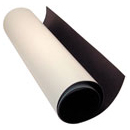
The term “flexible magnet” can be confusing. When most people think of magnets, they envision solid bars or pieces of metal. After all, magnets are defined by their ferromagnetic composition. They are comprised of a ferromagnetic metal — iron, cobalt, nickel, neodymium, etc. — that produces an invisible magnetic field. Nonetheless, flexible magnets are available. They produce an invisible magnetic field like all other magnets, but flexible magnets feature a unique design.
What Is a Flexible Magnet?
A flexible magnet is any magnetic object that’s designed to flex without breaking or otherwise sustaining damage. They aren’t stiff or hard. Flexible magnets can bend. Depending on the type (see below), in fact, you may be able to roll it up. You can’t bend other magnets. Unless a magnetic is flexible, it won’t bend without breaking.
Most flexible magnets consist of a synthetic substrate featuring a layer of ferromagnetic powder. The synthetic substrate is made of flexible material, such as vinyl. When ferromagnetic powder is applied to it, the synthetic substrate becomes magnetic. There are other production methods used for flexible methods, but many of them involve the application of ferromagnetic powder to a synthetic substrate. The powder is mixed with an adhesive or binding agent so that it sticks to the synthetic substrate.
Types of Flexible Magnets
Flexible magnets are available in several types. You can find flexible magnets available in sheets, for instance. Flexible magnetic sheets are often used on automobiles, metal cabinets, doors and buildings. They can be designed with either an adhesive backing or a PVC-laminated backing.
In addition to sheets, flexible magnets are available in strips. Flexible magnetic strips are longer and thinner than sheets. They are typically sold in rolls. Using this tape-like roll, you can run a flexible magnet across a ferromagnetic surface.
Benefits of Using Flexible Magnets
With their bendable properties, flexible magnets are versatile. They can easily wrap around machines, components and other surfaces. Even if a surface isn’t completely flat, it will probably support a flexible magnet.
You can cut and shape flexible magnets. Most flexible magnets can be cut using a traditional cutting tool. If you need a magnet in a specific size or shape, you can cut a flexible magnetic strip or sheet to accommodate your application.
You can also drill into flexible magnets. Drilling won’t cause them to crack. When you drill into a flexible magnetic, it will create a concentrated hole without affecting the surrounding magnetic material.
